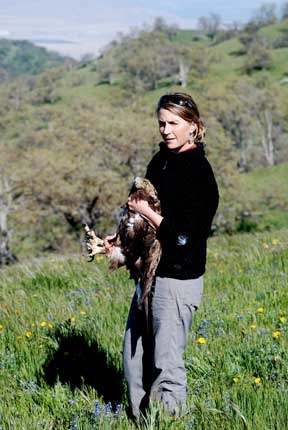UC Blogs
California's lead ammunition ban was product of years of research
California recently passed a law that will ban the use of lead ammunition when taking wildlife with a firearm. The intent is to protect scavenging birds and other wildlife from the threats of lead poisoning from spent lead ammunition.
While the new law, which was passed on Oct. 11, 2013, will be phased in over the next six years, the research that helped shape it has been going on for some time and much of it was done by researchers at the University of California, Davis.
UC Davis wildlife epidemiologist Terra Kelly (in photo at right) studied the effects of big game hunting on lead exposure in carrion-eating birds like eagles and turkey vultures and monitored the effect of a 2008 law that made it illegal to hunt with lead ammunition in eight counties within the California condor range. Kelly did her doctoral work with wildlife health expert Christine Johnson, associate professor of epidemiology at UC Davis School of Veterinary Medicine.
Scavenging birds and other animals are susceptible to lead poisoning when they inadvertently ingest spent pellets or bullet fragments in the tissues of animals killed by lead-based ammunition.
"Lead is a soft metal, so it fragments upon impact leaving hundreds of pieces around the wounded area of the animal," Kelly said. "Many scavengers forage in large groups, meaning a single carcass or gut-pile containing spent lead ammunition can expose many individuals."
Kelly and Johnson’s studies were funded by the California Department of Fish and Wildlife and published by the journal PLoS ONE in 2011.
While their research illuminates the threat posed by lead ammunition, Kelly and Johnson make clear that hunting itself is not the issue at hand.
"Hunting is an irreplaceable tool for wildlife management, especially now that we have fewer large predators but more invasive species like wild pigs," said Johnson in 2011, when the studies were published. "Yet we know that accidental consumption of lead can make animals and people sick."
"It just makes good sense to use non-lead ammunition, wherever it is available, to protect wildlife as well as eliminate any potential risk to hunters and their families," she added.
Lead poisoning has been an ongoing issue for birds at rehabilitation facilities, with Golden Eagles being hit especially hard.
"By the time they get to the center, we’re often unable to treat them because they’re so close to death," said Michelle Hawkins, director of the school's California Raptor Center. "We put in our best efforts, but very commonly it’s a losing battle. Prevention is definitely the way to keep these birds from having this problem."
National Geographic published a story about the lead ban on Oct. 11, quoting Johnson on the need for long-term monitoring of birds. She and Kelly say it should start right away so that wildlife can be tracked between now and 2019, when the law must be in full effect.
California growers awarded scholarships to attend the second annual “Principles of Pomology” extension course
The Fruit and Nut Research and Information Center (FNRIC) recently awarded four scholarships to new California tree fruit and nut growers to attend...
Master Gardeners at the Erickson Ranch
The Master Gardeners have had a presence at the Erickson Ranch and Dahlia Farm for many years. We have gone to “the Ranch” as many as 3 to 5 times each growing season. We provide a support table with pest notes, compost information, copies of ‘Seeds for Thought’, and info related to the theme of the event.
During the August event, the focus was on tomatoes, so we provided handouts about growing tomatoes, the vegetable planting guide by Dr. Robert Norris, and a page of the assorted tomato diseases and pests with photos. We had many clients with questions about their gardens and heard their stories about tomato successes and tomato failures. We answered questions and made suggestions for next year.
In September at the “all About Peppers” event, we provided the same support table but added info on planting peppers. We listened as people asked us how to get rid of white flies, tomato horn worms, and mildew on their plants.
Saturday was the last event for 2013 and the focus was on pumpkins. There were pumpkins to purchase, pumpkins to carve, and wagon rides out to the pumpkin patch. The Master Gardeners had the support table full of the usual information and added Halloween masks for the kids and instructions on how to build your own scarecrow. The families came in groups including grandparents, parents with babies in strollers and young children. The Erickson’s had their produce, flowers and jams for sale. The Charlie Wade Blues Band entertained the crowds. Nick, the BBQ man was cooking across the blacktop from Angelina’s biscotti table. Lucas was selling home grown plants while Cindy was making crafts with kids (headbands with fresh flowers being a favorite). Suisun Wildlife Rescue Center had an assortment of birds and reptiles on display. Under a white tent, children were carving pumpkins letting their creative juices flow. It was an entertainment extravaganza. And the best part of all was the six MG’s who volunteered in two shifts and were able to educate the crowds and enjoy the day! A real win-win!
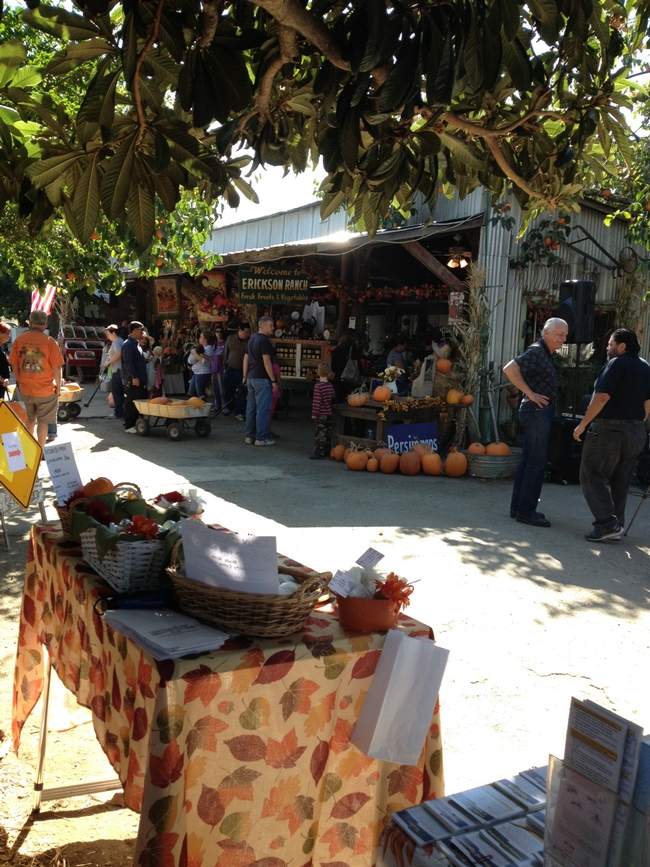
Erickson Ranch entry. (photos by Sharon Rico)
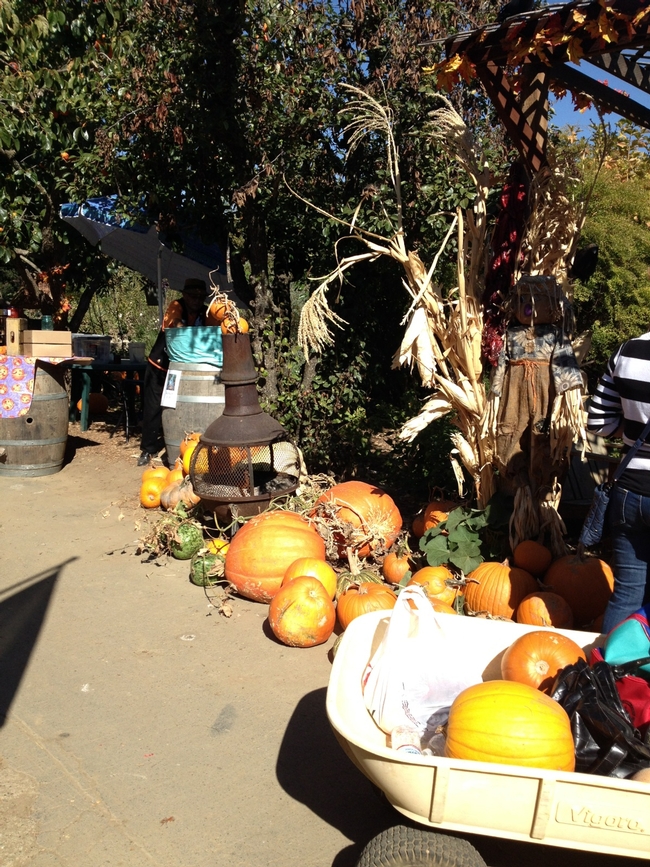
Pumpkins.
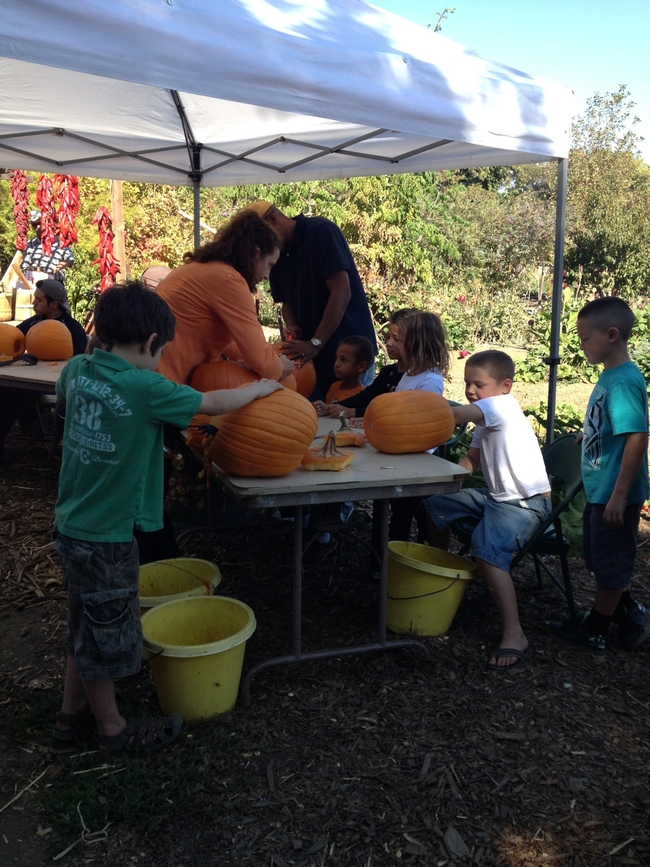
Carving up pumpkins.
Bees, Parasites and Maybe the End?
Thursday, Nov. 7 promises to be an exciting day for the Northern California Entomology Society--a great presentation by UC Davis evolutionary...
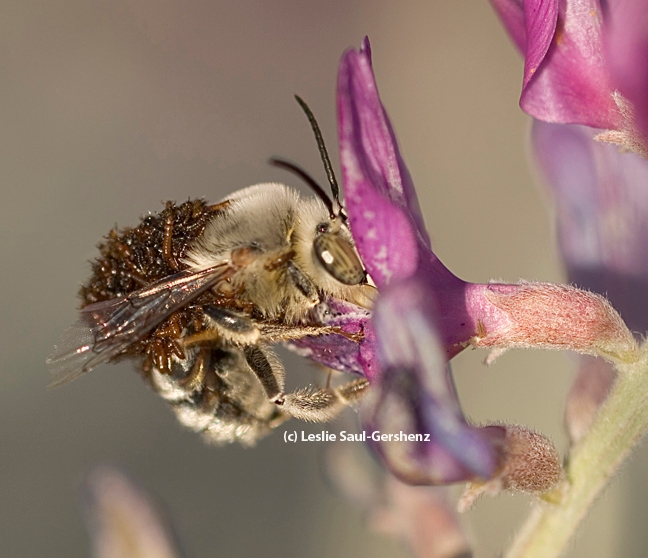
A digger bee, Habropoda pallida, with blister beetle larvae. (Photo by Leslie Saul-Gershenz)
Old Man Squash
Every year I look forward to choosing my fall display of winter squash to both enjoy as art as well as blend up in a hearty curry soup. As a fanciful display, I pile the squash and gourds up near my front door as a cheerful welcome home for my family and friends. The other day my first beauty arrived. It is peculiar, a grayish blue with deep vertical grooves surrounding the body. My neighbor calls it "Old Man Squash", it is so cute. I doubt that it will ever end up in a soup. In the last few years, I have noticed that even our local grocery stores are carrying an extensive collection of these beauties, far beyond the usual "Jack 'O Lantern" pumpkins. I am anxious to check out the roadside stands throughout our county to see what colorful gems they have grown this season.
If you get energetic next spring you might want to check out some of the seed sources now for an extensive variety of squash seeds to choose from. I found the following sources have quite a few of the more unusual varieties out there: www.botanicalinterests.com, sustainableseedco.com, www.seedsavers.org, nativeseeds.org, victoryseeds.com and rareseeds.com (Baker Creek Heirloom Seed Company).
Reading through some of the squash descriptions reminded me of the legendary companion planting "Three Sisters", corn, pole beans and squash (or pumpkin). Each sister contributes to the group. The corn offer support to the pole beans, the beans fix nitrogen from the air and bring it into the soil for the benefit of all three, the bean vines wrap around and hold them together and the squash leaves provide cooling shade for the soil and prevent weeds from intruding. By the time European settlers arrived on the east coast, the Iroquois had been following this planting practice for over three centuries. In legend these plants were seen as a gift from the gods, always to be grown together, eaten together and celebrated together.
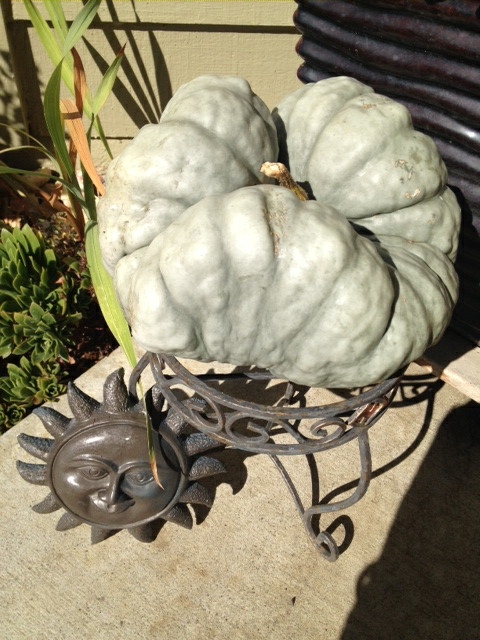
The wrinkly old man squash. (photo by Trisha Rose)


